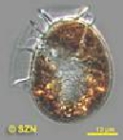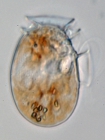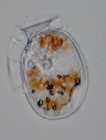WoRMS taxon details
Dinophysis ovum T.H.Abé, 1967
marine, fresh, terrestrial
Not documented
Description Small to medium-sized cells (32–42 μm in length). In side view, somewhat irregularly egg-shaped, rather asymmetrical...
Description Small to medium-sized cells (32–42 μm in length). In side view, somewhat irregularly egg-shaped, rather asymmetrical with an apex narrower than the broad rounded antapex; ventral contour until R3 slightly convex, and from there onwards, more or less broad and rounded; dorsal contour always more strongly convex than the ventral one. The broader depth of the cell is at the height of R3, or slightly lower. The ratio between the maximum length and dorso-ventral depth (L/D) of the large hypothecal plates (LHP) ranges from 1.3 to 1.4. These LHP exhibit a rough areolation, and most of the areolae have a central pore. [details]
Guiry, M.D. & Guiry, G.M. (2025). AlgaeBase. World-wide electronic publication, National University of Ireland, Galway (taxonomic information republished from AlgaeBase with permission of M.D. Guiry). Dinophysis ovum T.H.Abé, 1967. Accessed through: World Register of Marine Species at: https://marinespecies.org/aphia.php?p=taxdetails&id=646201 on 2025-04-17
Date
action
by
2012-09-04 13:39:36Z
created
db_admin
2012-10-23 08:50:40Z
changed
db_admin
Copyright notice: the information originating from AlgaeBase may not be downloaded or replicated by any means, without the written permission of the copyright owner (generally AlgaeBase). Fair usage of data in scientific publications is permitted.
Nomenclature
basis of record
Guiry, M.D. & Guiry, G.M. (2025). AlgaeBase. <em>World-wide electronic publication, National University of Ireland, Galway.</em> searched on YYYY-MM-DD., available online at http://www.algaebase.org [details]
Ecology
ecology source
Harred, L. B.; Campbell, L. (2014). Predicting harmful algal blooms: a case study with Dinophysis ovum in the Gulf of Mexico. <em>Journal of Plankton Research.</em> 36(6): 1434-1445., available online at https://doi.org/10.1093/plankt/fbu070 [details]
ecology source Mitra, A.; Caron, D. A.; Faure, E.; Flynn, K. J.; Leles, S. G.; Hansen, P. J.; McManus, G. B.; Not, F.; Do Rosario Gomes, H.; Santoferrara, L. F.; Stoecker, D. K.; Tillmann, U. (2023). The Mixoplankton Database (MDB): Diversity of photo‐phago‐trophic plankton in form, function, and distribution across the global ocean. <em>Journal of Eukaryotic Microbiology.</em> 70(4)., available online at https://doi.org/10.1111/jeu.12972 [details]
ecology source Mafra Jr., L. L.; Nagai, S.; Uchida, H.; Tavares, C. P.; Escobar, B. P.; Suzuki, T. (2016). Harmful effects of Dinophysis to the ciliate Mesodinium rubrum: Implications for prey capture. <em>Harmful Algae.</em> 59: 82-90., available online at https://doi.org/10.1016/j.hal.2016.09.009 [details]
ecology source Mitra, A.; Caron, D. A.; Faure, E.; Flynn, K. J.; Leles, S. G.; Hansen, P. J.; McManus, G. B.; Not, F.; Do Rosario Gomes, H.; Santoferrara, L. F.; Stoecker, D. K.; Tillmann, U. (2023). The Mixoplankton Database (MDB): Diversity of photo‐phago‐trophic plankton in form, function, and distribution across the global ocean. <em>Journal of Eukaryotic Microbiology.</em> 70(4)., available online at https://doi.org/10.1111/jeu.12972 [details]
ecology source Mafra Jr., L. L.; Nagai, S.; Uchida, H.; Tavares, C. P.; Escobar, B. P.; Suzuki, T. (2016). Harmful effects of Dinophysis to the ciliate Mesodinium rubrum: Implications for prey capture. <em>Harmful Algae.</em> 59: 82-90., available online at https://doi.org/10.1016/j.hal.2016.09.009 [details]
Other
context source (HKRMS)
Lam CWY. & Ho KC. (1988). Phytoplankton characteristics of Tolo Harbour. In: Morton B, editor. Asian Marine Biology 6. pp 5-18. Hong Kong University Press, Hong Kong. [details]
context source (RAS) Australian Antarctic Data Centre. , available online at https://data.aad.gov.au/aadc/biodiversity/ [details]
context source (Bermuda) Hulburt, E. M.; Ryther, J. H.; Guillard, R. R. L. (1960). The phytoplankton of the Sargasso Sea off Bermuda Also In: The Plankton Ecology and Related Chemistry and Hydrography of the Sargasso Sea Progress Report: Sep. 1957 - Apr. 1959 AEC Contract No. AT(30-1)-2078. Journal du Conseil International pour l’Exploration de la Mer, 15: 115-128 [details]
additional source Abé, T.H. (1967). The armoured Dinoflagellata: II. Prorocentridae and Dinophysidae (B) - <i>Dinophysis</i> and its allied genera. <em>Publications of the Seto Marine Biological Laboratory.</em> 2: 37-78. [details] Available for editors [request]
[request]
additional source Moestrup, Ø., Akselman, R., Cronberg, G., Elbraechter, M., Fraga, S., Halim, Y., Hansen, G., Hoppenrath, M., Larsen, J., Lundholm, N., Nguyen, L. N., Zingone, A. (Eds) (2009 onwards). IOC-UNESCO Taxonomic Reference List of Harmful Micro Algae., available online at http://www.marinespecies.org/HAB [details]
context source (RAS) Australian Antarctic Data Centre. , available online at https://data.aad.gov.au/aadc/biodiversity/ [details]
context source (Bermuda) Hulburt, E. M.; Ryther, J. H.; Guillard, R. R. L. (1960). The phytoplankton of the Sargasso Sea off Bermuda Also In: The Plankton Ecology and Related Chemistry and Hydrography of the Sargasso Sea Progress Report: Sep. 1957 - Apr. 1959 AEC Contract No. AT(30-1)-2078. Journal du Conseil International pour l’Exploration de la Mer, 15: 115-128 [details]
additional source Abé, T.H. (1967). The armoured Dinoflagellata: II. Prorocentridae and Dinophysidae (B) - <i>Dinophysis</i> and its allied genera. <em>Publications of the Seto Marine Biological Laboratory.</em> 2: 37-78. [details] Available for editors
additional source Moestrup, Ø., Akselman, R., Cronberg, G., Elbraechter, M., Fraga, S., Halim, Y., Hansen, G., Hoppenrath, M., Larsen, J., Lundholm, N., Nguyen, L. N., Zingone, A. (Eds) (2009 onwards). IOC-UNESCO Taxonomic Reference List of Harmful Micro Algae., available online at http://www.marinespecies.org/HAB [details]
 Present
Present  Present in aphia/obis/gbif/idigbio
Present in aphia/obis/gbif/idigbio  Inaccurate
Inaccurate  Introduced: alien
Introduced: alien  Containing type locality
Containing type locality
From regional or thematic species database
Description Small to medium-sized cells (32–42 μm in length). In side view, somewhat irregularly egg-shaped, rather asymmetrical with an apex narrower than the broad rounded antapex; ventral contour until R3 slightly convex, and from there onwards, more or less broad and rounded; dorsal contour always more strongly convex than the ventral one. The broader depth of the cell is at the height of R3, or slightly lower. The ratio between the maximum length and dorso-ventral depth (L/D) of the large hypothecal plates (LHP) ranges from 1.3 to 1.4. These LHP exhibit a rough areolation, and most of the areolae have a central pore. [details]Harmful effect OA found in picked cells from Galicia (7 pg/cell of OA, Raho et al. 2008) and in cultures from Gulf of Texas strains (Fux et al. 2011). Blooms have been associated with DSP outbreaks in Termaikos Bay (Papaefthimiou et al. 2010) and the exceptional 2008 bloom in Texas (Deeds et al. 2010; Swanson et al.2010; Campbell et al. 2010).
Dinophysis ovum is often misidentified as D. acuminata. However, strains from Galicia, Greece and Texas were well separated from D. acuminata based on the sequence of the mitochondrial cox 1 gene (Raho et al. 2008). [details]
Identification Dinophysis ovum is often misidentified as D. acuminata. However, strains from Galicia, Greece and Texas were well separated from D. acuminata, based on the sequence of the mitochondrial cox 1 gene (Raho et al. 2008). [details]




